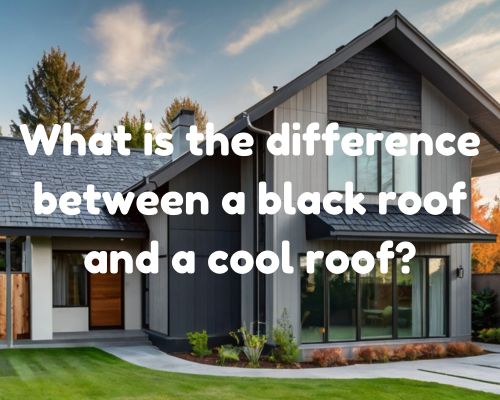Choosing the right roof for your home or commercial building involves understanding the functional and aesthetic differences between black roofs and cool roofs.
Based on Star Roofing Contractors, a black roof, while visually striking, tends to absorb more heat. This can cause the roof to reach temperatures as high as 190°F during the summer. As a result, the building’s internal temperature increases, leading to higher energy costs for cooling.

In contrast, a cool roof reflects more sunlight and absorbs less heat, helping to keep your building cooler. This can significantly reduce rooftop temperatures, sometimes by as much as 55°F, which can contribute to improved energy efficiency and lower cooling costs. If you live in a warmer climate, the benefits of a cool roof are particularly pronounced.
Your choice between a black roof and a cool roof will depend on various factors, including climate, energy efficiency priorities, and aesthetic preferences. For colder climates, a black roof might provide the benefit of added warmth, whereas in hotter regions, a cool roof offers better thermal performance and energy savings.
Fundamentals of Roof Types and Their Impact on Climate
Different roof types, such as cool roofs and black roofs, play a significant role in impacting climate, energy efficiency, and urban temperature levels. With Star Roofing Contractors, get delve into specific aspects and comparisons between these roof types.
Understanding Cool Roofs
Cool roofs are designed to reflect more sunlight and absorb less heat compared to standard roofs. These roofs often have a lighter color or a reflective coating that boosts their solar reflectance. Materials used in cool roofs, like reflective shingles or tiles, can significantly lower the roof’s surface temperature.
High solar reflectance and thermal emittance are crucial properties for cool roofs. For example, a cool roof can reduce a building’s cooling costs by reflecting up to 80% of incoming sunlight. This not only cuts down on air conditioning usage but also combats the urban heat island effect by keeping surrounding areas cooler.
Black Roofs Explained
Black roofs, generally made of dark asphalt or similar materials, absorb much more heat from sunlight. The temperature on black roofs can soar up to 190°F in the summer, significantly higher than cool roofs. This absorbed heat contributes to increased interior temperatures, demanding more air conditioning and, consequently, higher energy bills.
The heat absorption properties of black roofs can further exacerbate the heat island effect in urban settings, where numerous dark surfaces collectively raise local temperatures. While effective in cooler climates by aiding with heating, black roofs are less sustainable and less energy-efficient in warmer regions.
Comparing Energy Efficiency
When comparing cool roofs and black roofs in terms of energy efficiency, cool roofs significantly outperform. Cool roofs reflect sunlight and emit absorbed radiation more efficiently, resulting in lower cooling costs. They are particularly beneficial in hot climates where air conditioning usage is high.
Conversely, black roofs might be slightly advantageous in colder climates by reducing heating costs. However, their overall energy savings are generally lower due to high cooling requirements in warmer seasons. Adopting cool roofs can lead to substantial reductions in energy bills and contribute towards more sustainable urban development.
Practical Considerations for Homeowners and Building Owners
When considering the difference between a black roof and a cool roof, it is essential to evaluate aspects such as selection and installation, benefits and drawbacks, and maintenance requirements. The right choice can impact your building’s energy efficiency, durability, and overall performance.
Selection and Installation Factors
Choosing between a black roof and a cool roof involves examining various roofing materials, including asphalt shingles, metal, tile, and single-ply membranes. Light-colored roofs or those with reflective coatings are more effective in reducing rooftop temperatures. Factors such as climate, building design, and local regulations also play critical roles.
- In warmer climates, cool roofs help mitigate heat gain.
- In northern climates, a dark roof might be preferable for snow and ice melting.
- Consider whether your building is residential or commercial, as this can influence the ideal roofing system.
Installation is performed by a professional roofing contractor like Star Roofing Contractors, and it’s essential to check their experience with different roof types to ensure quality workmanship.
Benefits and Drawbacks of Roof Choices
Cool roofs offer numerous benefits, including:
- Lower energy costs due to reduced air conditioning use.
- Enhanced durability as the materials experience less thermal stress.
- Positive impact on greenhouse gas emissions and surrounding air quality.
On the flip side, there are considerations like:
- Potential increased heating costs in colder regions.
- Initial investment might be higher compared to traditional roofs.
Black roofs provide:
- Better snow and ice melting in colder climates.
- Lower material cost, especially in asphalt shingles.
However, they can contribute to higher HVAC loads and potential urban heat island effect, impacting both commercial and residential buildings.
Maintenance and Longevity Considerations
Maintenance requirements vary between cool and black roofs.
Cool roofs may need more frequent cleaning to maintain reflectivity. This is especially true in areas with high levels of dirt and pollution. Periodic maintenance also ensures that cool roofs retain their energy efficiency and durability.
For black roofs, regular inspections for leaks and degradation are crucial. While materials like metal roofs or concrete tiles often last longer, asphalt shingle roofs might require more frequent replacement.
Engaging a knowledgeable roofing contractor for periodic checks and maintenance is vital. This will help prolong the lifespan of your roof, regardless of the type. It will also ensure your roofing system continues to perform optimally.